Development of Ship Route-Planning Algorithm Based on Rapidly-Exploring Random Tree (RRT*) Using Designated Space
Abstract
1. Introduction
- We constructed a map space reflecting the characteristics of ships and created a global route in coastal waters. Geometric elements and morphological image processing were used to expand the size of obstacles to generate a safe path.
- By constructing a designated navigational space as a multi-ellipse, our method can generate efficient routes quickly compared to classic sampling-based route planning algorithm methods in a wide range of sea spaces.
- To simplify the generated route, we used graph algorithms to eliminate unnecessary nodes and visualize the shortest-distance paths, avoiding collisions with obstacles.
2. Related Literature Review
2.1. Ship’s Route-Planning Process
- The dimension of the ship;
- The accuracy of the navigational systems;
- Tidal streams; and
- The maneuvering characteristics of the ship.
2.2. Sampling-Based Route-Planning Algorithm
2.2.1. The Probabilistic Road Map (PRM) Algorithm
2.2.2. The Rapidly-Exploring Random Tree (RRT) Algorithm
2.2.3. The Improved RRT* Algorithm
2.3. Implications
3. Methods
3.1. Process Flow of the Algorithm
3.2. Binary Occupancy Map Creation
3.3. Generating Initial Route Based on the PRM Algorithm
3.4. The Designated RRT* Algorithm Using Multiple-Ellipse Space
3.5. Route Optimization
3.5.1. Boundary Detection
3.5.2. Collision-Free Space Graph
4. Results and Discussions
5. Conclusions
Author Contributions
Funding
Institutional Review Board Statement
Informed Consent Statement
Data Availability Statement
Conflicts of Interest
References
- Lee, W.H.; Choi, G.H.; Kim, T.W. Visibility graph-based path-planning algorithm with quadtree representation. Appl. Ocean Res. 2021, 117, 102887. [Google Scholar] [CrossRef]
- Lee, L.N.; Kim, J.S. Development of priority index for intelligent vessel traffic monitoring system in vessel traffic service areas. Appl. Sci. 2022, 12, 3807. [Google Scholar] [CrossRef]
- Lozano-Perez, T. Spatial planning: A configuration space approach. IEEE Trans. Comput. 1983, 100, 108–120. [Google Scholar] [CrossRef]
- Sleumer, N.; Tschichold-Gürmann, N. Exact Cell Decomposition of Arrangements Used for Path Planning in Robotics; Technical Report/ETH Zurich, Department of Computer Science 329: Zürich, Switzerland, 1999. [Google Scholar]
- Amato, N.M.; Wu, Y. A Randomized Roadmap Method for Path and Manipulation Planning. In Proceedings of the IEEE International Conference on Robotics and Automation, Minneapolis, MN, USA, 22–28 April 1996; Volume 1, pp. 113–120. [Google Scholar]
- LaValle, S.M. Rapidly-exploring random trees: A new tool for path planning. Res. Rep. 1998, 9811, 1–4. Available online: https://www.cs.csustan.edu/~xliang/Courses/CS4710-21S/Papers/06%20RRT.pdf (accessed on 8 November 2022).
- Brooks, R.A.; Lozano-Pérez, T. A subdivision algorithm in configuration space for find path with rotation. IEEE Trans. Syst. Man Cybern. 1985, SMC-15, 224–233. [Google Scholar] [CrossRef]
- Mark, B.; Cheong, O.; Krevel, M.; Overmars, M. Computational Geometry: Algorithms and Applications; Springer: Berlin/Heidelberg, Germany, 2008; ISBN 978-3-540-77973-5. [Google Scholar]
- Fiorini, P.; Shiller, Z. Motion planning in dynamic environments using velocity obstacles. Int. J. Robot. Res. 1998, 17, 760–772. [Google Scholar] [CrossRef]
- Choset, H.; Burdick, J. Sensor Based Planning. I. The Generalized Voronoi Graph. In Proceedings of the 1995 IEEE International Conference on Robotics and Automation, Nagoya, Japan, 21–27 May 1995; pp. 1649–1655. [Google Scholar]
- Hsu, D.; Kavraki, L.E.; Latombe, J.C.; Motwani, R.; Sorkin, S. On finding narrow passages with probabilistic roadmap planners. In Robotics: The Algorithmic Perspective: 1998 Workshop on The Algorithmic Foundations of Robotics; A K Peters/CRC Press: New York, NY, USA, 1998; pp. 141–154. [Google Scholar]
- Dijkstra, E.W. A note on two problems in connexion with graphs. Numer. Math. 1959, 1, 269–271. [Google Scholar] [CrossRef]
- Hart, P.E.; Nilsson, N.J.; Raphael, B. A formal basis for the heuristic determination of minimum cost paths. IEEE Trans. Syst. Sci. Cybern. 1968, 4, 100–107. [Google Scholar] [CrossRef]
- Bellman, R. On a routing problem. Quart. Appl. Math. 1958, 16, 87–90. [Google Scholar] [CrossRef]
- Szlapczynska, J. Multi-objective weather routing with customised criteria and constraints. J. Navig. 2015, 68, 338–354. [Google Scholar] [CrossRef]
- Sen, D.; Padhy, C.P. An approach for development of a ship routing algorithm for application in the north Indian ocean region. Appl. Ocean Res. 2015, 50, 173–191. [Google Scholar] [CrossRef]
- Vettor, R.; Guedes Soares, C. Development of a ship weather routing system. Ocean Eng. 2016, 123, 1–14. [Google Scholar] [CrossRef]
- IMO. IMO Resolution A. 893(21) Guidelines for Voyage Planning; IMO: London, UK, 1999. [Google Scholar]
- Shah, B.C.; Gupta, S.K. Long-distance path planning for unmanned surface vehicles in complex marine environment. J. Ocean. Eng. 2019, 45, 813–830. [Google Scholar] [CrossRef]
- Niu, H.L.; Savvaris, A.; Tsourdos, A.; Ji, Z. Voronoi-visibility roadmap-based path planning algorithm for unmanned Surface vehicles. J. Navig. 2019, 72, 850–874. [Google Scholar] [CrossRef]
- Ari, I.; Aksakalli, V.; Aydog, V.; Kum, S. Optimal ship navigation with safety distance and realistic turn constraints. Eur. J. Oper. Res. 2013, 229, 707–717. [Google Scholar] [CrossRef]
- Shi, B.; Su, Y.; Zhang, H.; Liu, J.; Wan, L. Obstacles modeling method in cluttered environments using satellite images and its application to path planning for USV. Int. J. Nav. Archit. Ocean Eng. 2018, 11, 202–210. [Google Scholar] [CrossRef]
- Ozkan, M.F.; Carrillo, L.R.G.; King, S.A. Rescue Boat Path Planning in Flooded Urban Environments. In Proceedings of the 2019 IEEE International Symposium on Measurement and Control in Robotics (ISMCR), Houston, TX, USA, 19–21 September 2019; pp. B2-2-1–B2-2-9. [Google Scholar]
- Kavraki, L.E.; Svestka, P.; Latombe, J.C.; Overmars, M.H. Probabilistic roadmaps for path planning in high-dimensional configuration spaces. IEEE Trans. Robot. Autom. 1996, 12, 566–580. [Google Scholar] [CrossRef]
- Kavraki, L.E.; Kolountzakis, M.N.; Latombe, J.C. Analysis of probabilistic roadmaps for path planning. IEEE Trans. Robot. Autom. 1998, 14, 166–171. [Google Scholar] [CrossRef]
- LaValle, S.M.; Kuffner, J.J., Jr. Randomized kinodynamic planning. Int. J. Robot. Res. 2001, 20, 378–400. [Google Scholar] [CrossRef]
- Karaman, S.; Frazzoli, E. Sampling-based algorithms for optimal motion planning. Int. J. Robot. Res. 2011, 30, 846–894. [Google Scholar] [CrossRef]
- Karaman, S.; Frazzoli, E. Incremental sampling-based algorithms for optimal motion planning. In Robotics: Science and Systems; MIT Press: Cambridge, MA, USA, 2011; Volume 6, pp. 267–274. [Google Scholar]
- Geraerts, R.; Overmars, M.H. A comparative study of probabilistic roadmap planners. In Algorithmic Foundations of Robotics V; Springer: Berlin/Heidelberg, Germany, 2004; pp. 43–57. [Google Scholar]
- Kim, J.T.; Kim, D.J. Single-query probabilistic roadmap planning algorithm using remembering exploration method. J. KIISE Comput. Pract. Lett. 2010, 16, 487–491. [Google Scholar]
- International Chamber of Shipping. Bridge Procedures Guide, 5th ed.; International Chamber of Shipping: London, UK, 2016. [Google Scholar]
- Ministry of Ocean and Fisheries (MOF). Port and Harbor Design Standards; MOF: Sejong City, Korea, 2017. [Google Scholar]
- Bhattacharya, P.; Gavrilova, M.L. Roadmap-based path planning-using the voronoi diagram for a clearance-based shortest path. IEEE Robot. Autom. Mag. 2008, 15, 58–66. [Google Scholar] [CrossRef]
- Plaku, E.; Bekris, K.E.; Chen, B.Y.; Ladd, A.M.; Kavraki, L.E. Sampling-based roadmap of trees for parallel motion planning. IEEE Trans. Robot. 2005, 21, 597–608. [Google Scholar] [CrossRef]
- International Maritime Organization. ECDIS—Guidance for Good Practice, MSC.1-Circ.1503-Rev.1; IMO: London, UK, 2017. [Google Scholar]
- Lee, Y.; Kim, J.H. A computational improvement of Otsu’s algorithm by estimating approximate threshold. J. Korea Multimed. Soc. 2017, 20, 163–169. [Google Scholar] [CrossRef][Green Version]
- Otsu, N. A Threshold Selection Method from Gray-Level Histograms. IEEE Trans. Syst. Man Cybern. 1979, 9, 62–66. [Google Scholar] [CrossRef]
- IMO. Standards for Ship Maneuverability; Resolution MSC.137(76); IMO: London, UK, 2002. [Google Scholar]
- Haralick, R.M.; Shapiro, L.G. Computer and Robot Vision, 1st ed.; Addison-Wesley Reading: Boston, MA, USA, 1992. [Google Scholar]
- Yang, A.; Niu, Q.; Zhao, W.; Li, K.; Irwin, G.W. An Efficient Algorithm for Grid-Based Robotic Path Planning Based on Priority Sorting of Direction Vectors. In Life System Modeling and Intelligent Computing; ICSEE 2010 LSMS 2010; Lecture Notes in Computer Science; Springer: Berlin/Heidelberg, Germany, 2010; Volume 6329. [Google Scholar]
- Gonzalez, R.C.; Eddins, S.L.; Woods, R.E. Digital Image Publishing Using MATLAB, 1st ed.; Prentice Hall: Upper Saddle River, NJ, USA, 2004. [Google Scholar]
- Batko, Y.; Dyminsky, Y. Fast contour tracing algorithm based on a backward contour tracing method. In Proceedings of the ACIT 2018: International Conference “Advanced Computer Information Technologies”, Ceske Budejovice, Czech Republic, 1–3 June 2018. [Google Scholar]

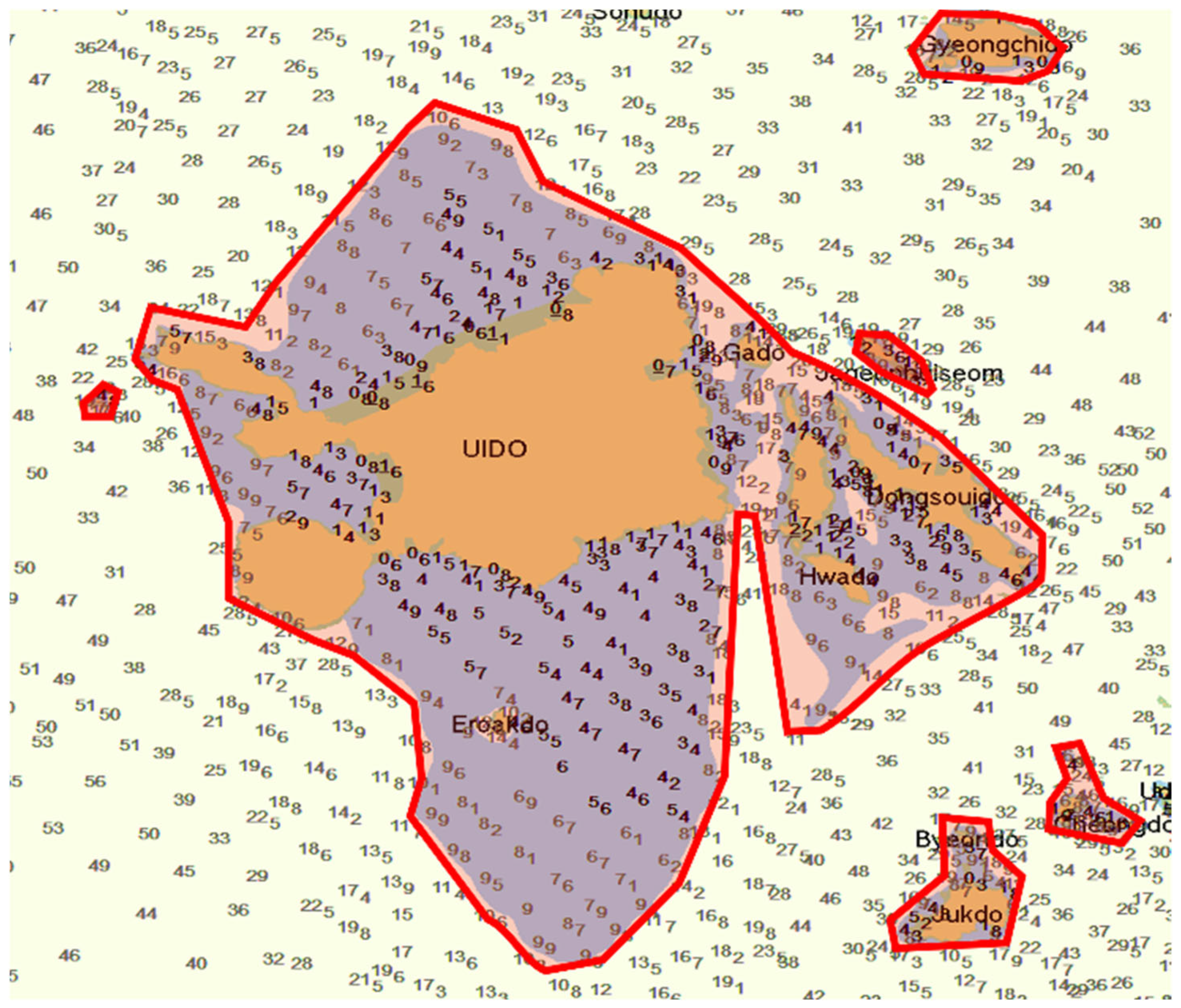
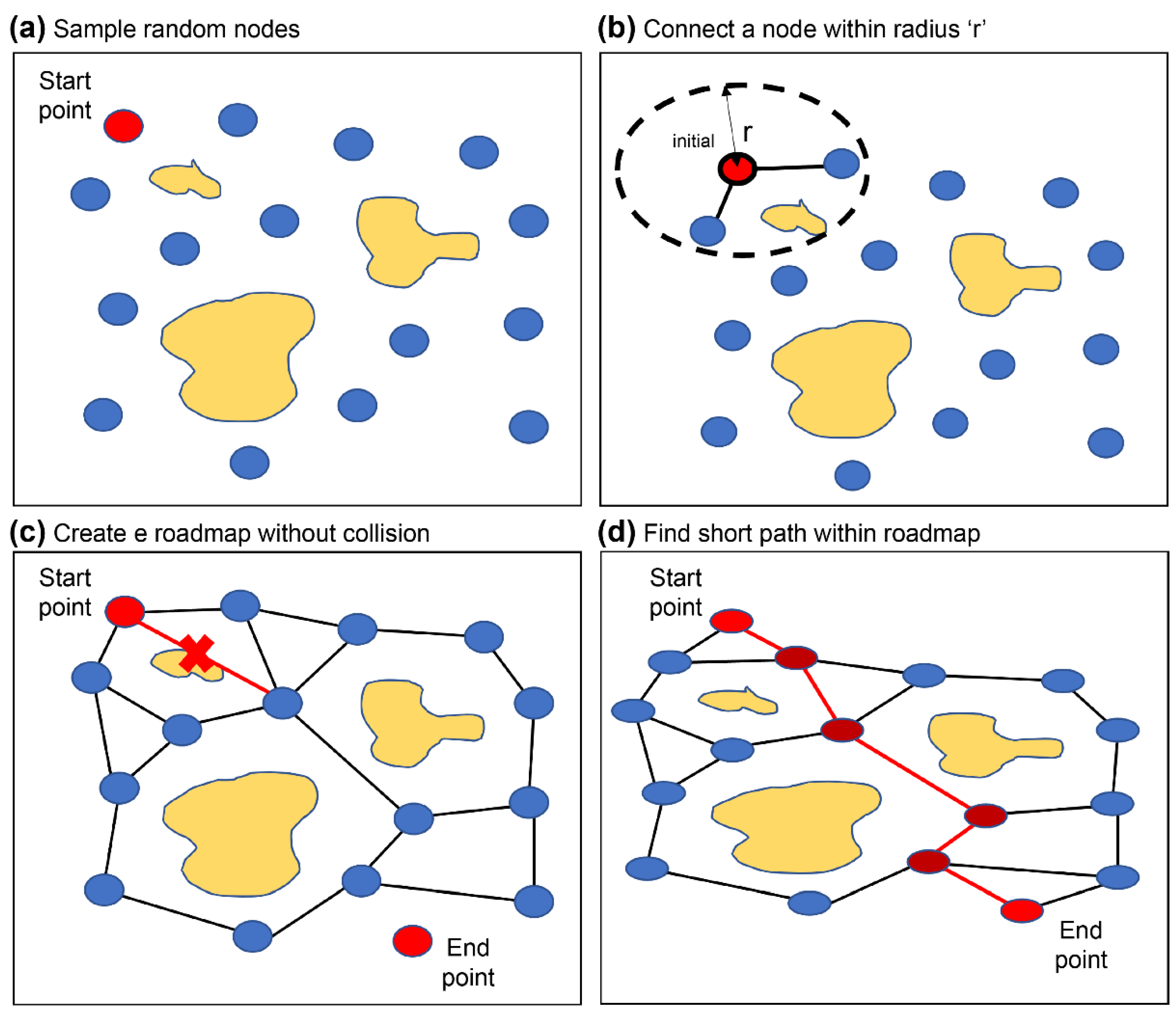
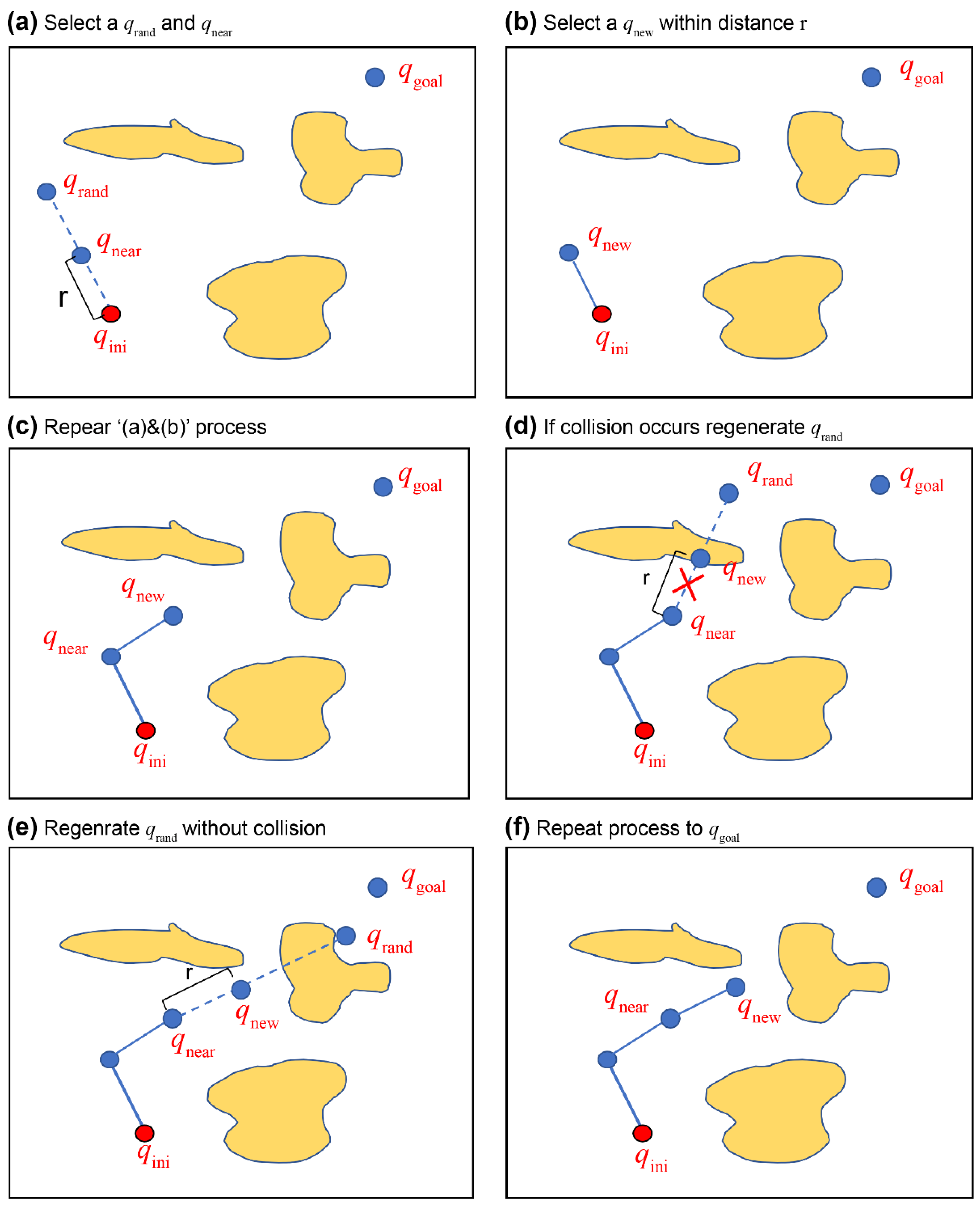
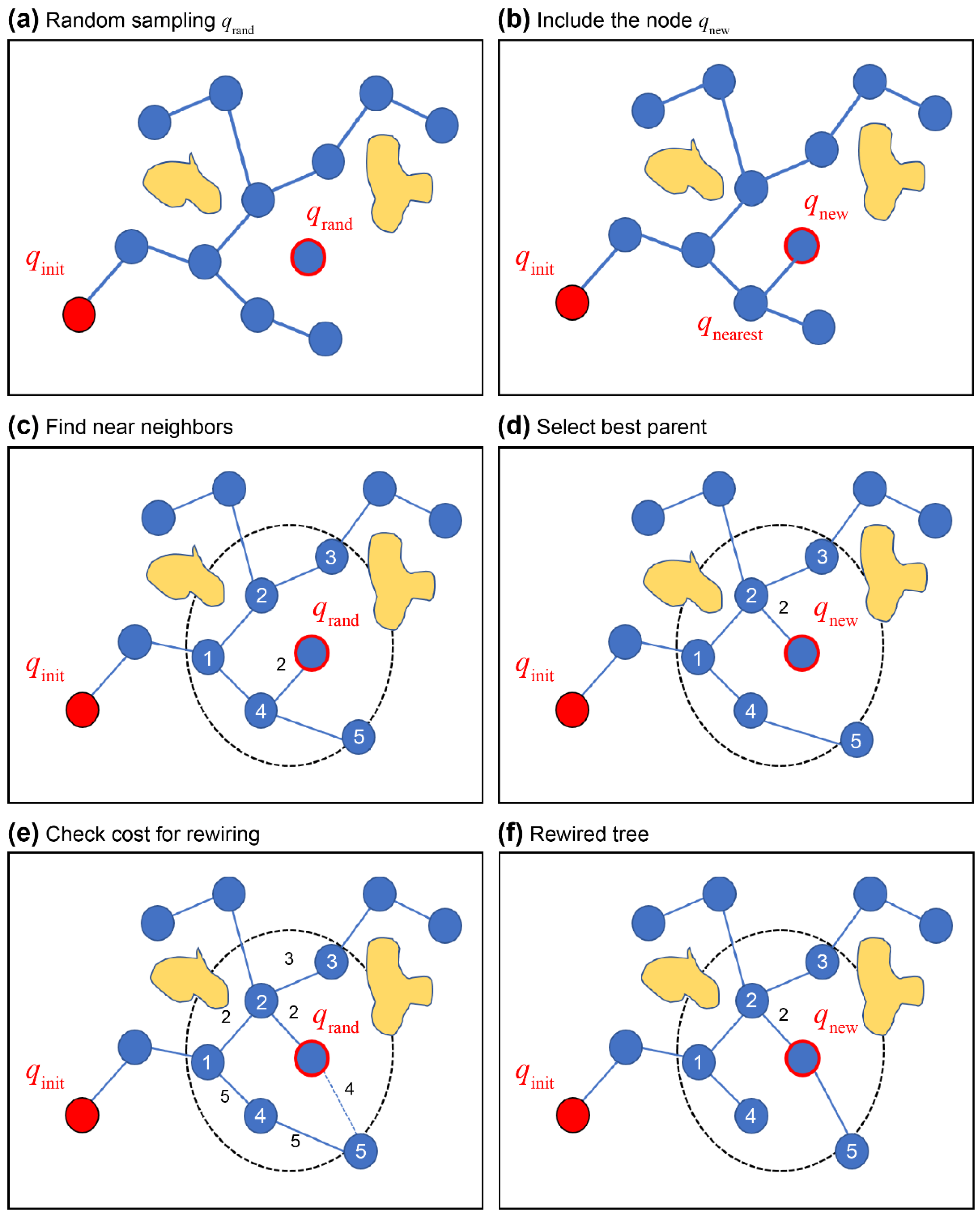
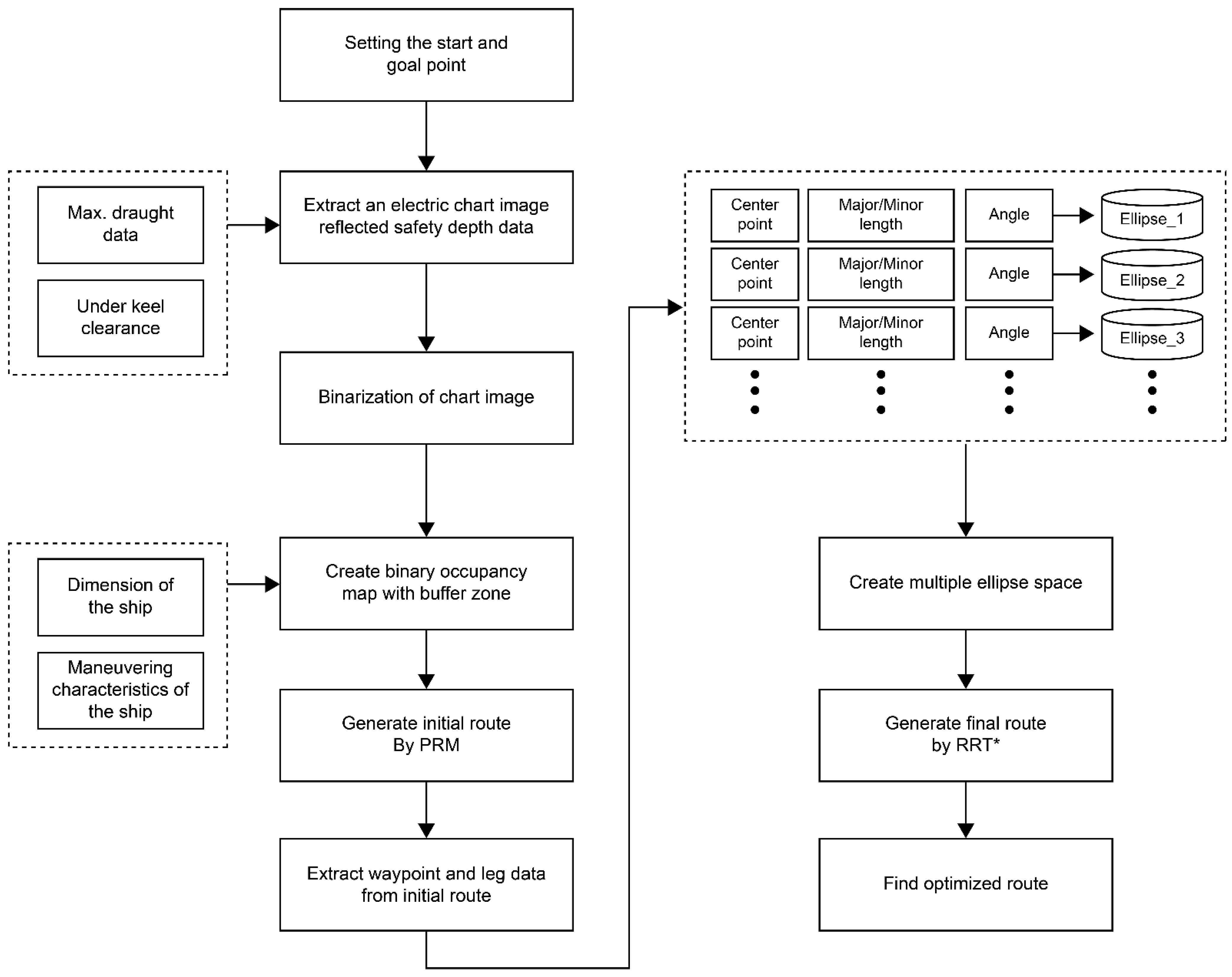
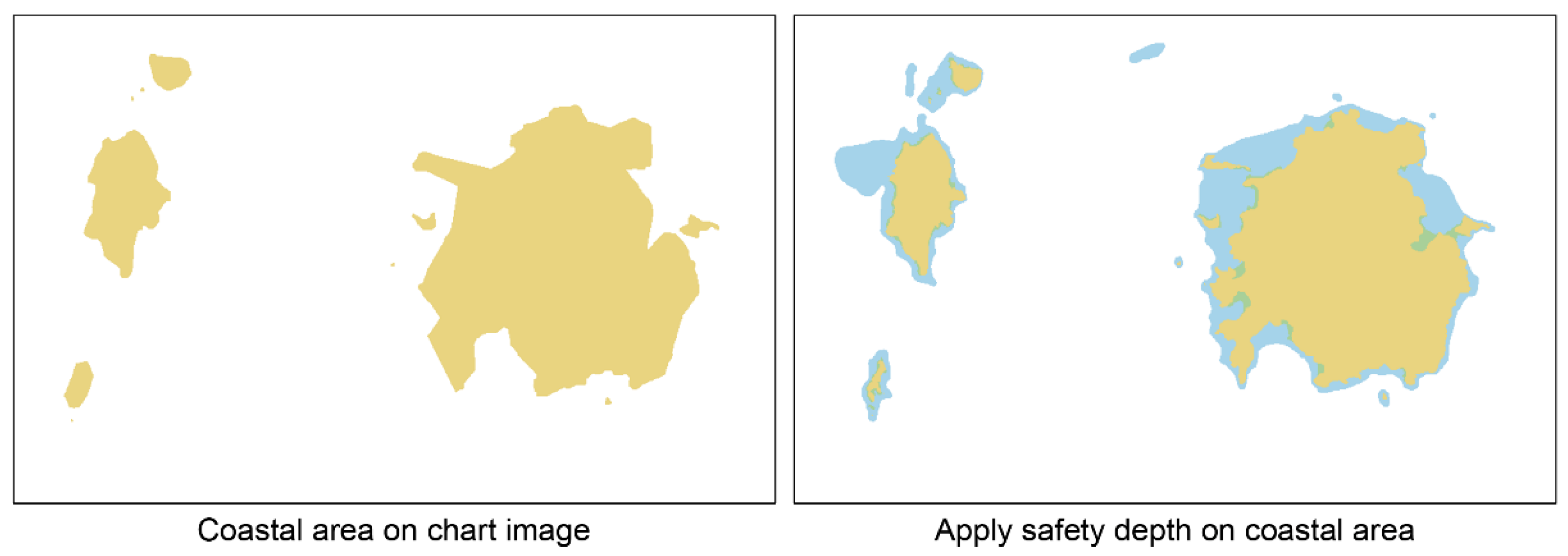
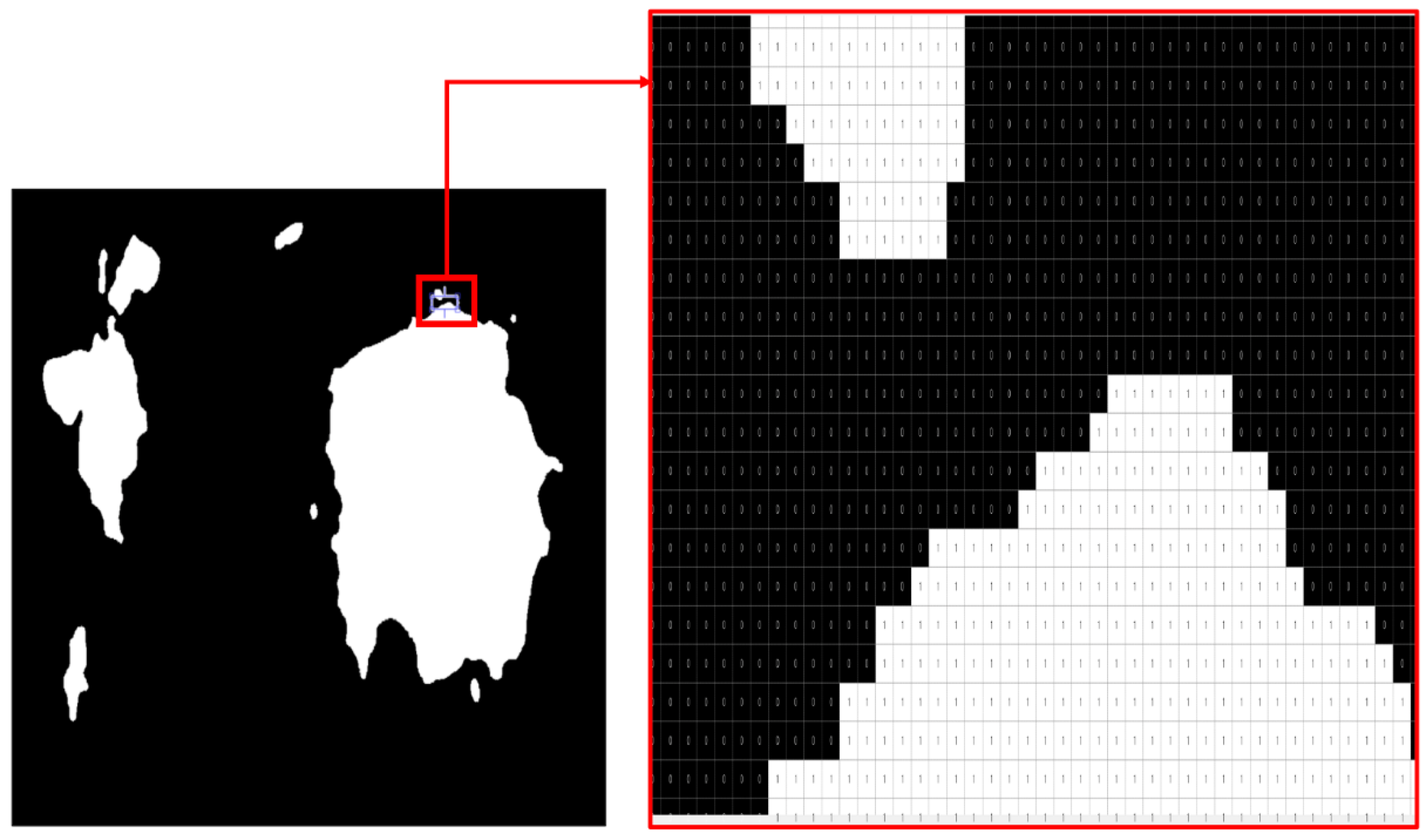
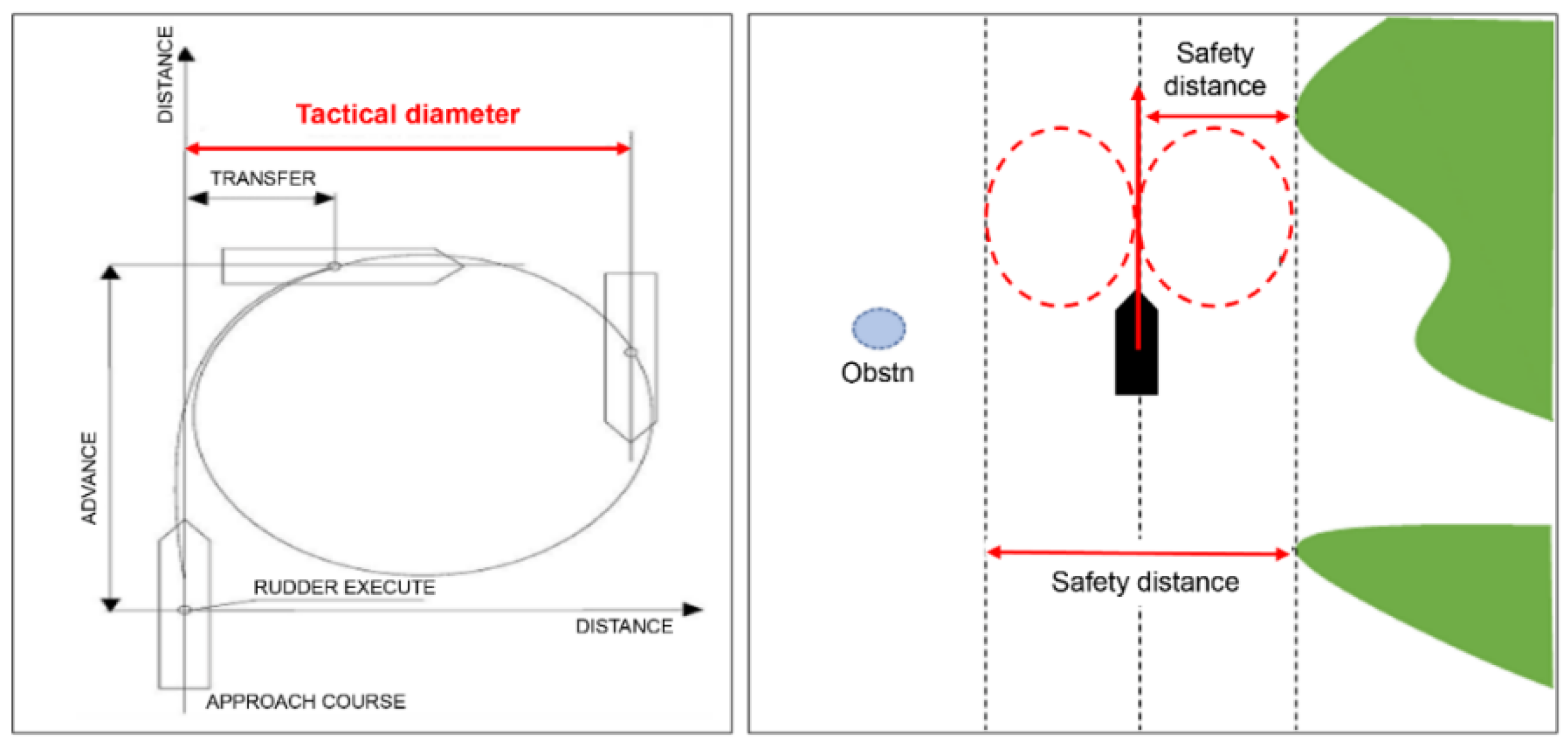

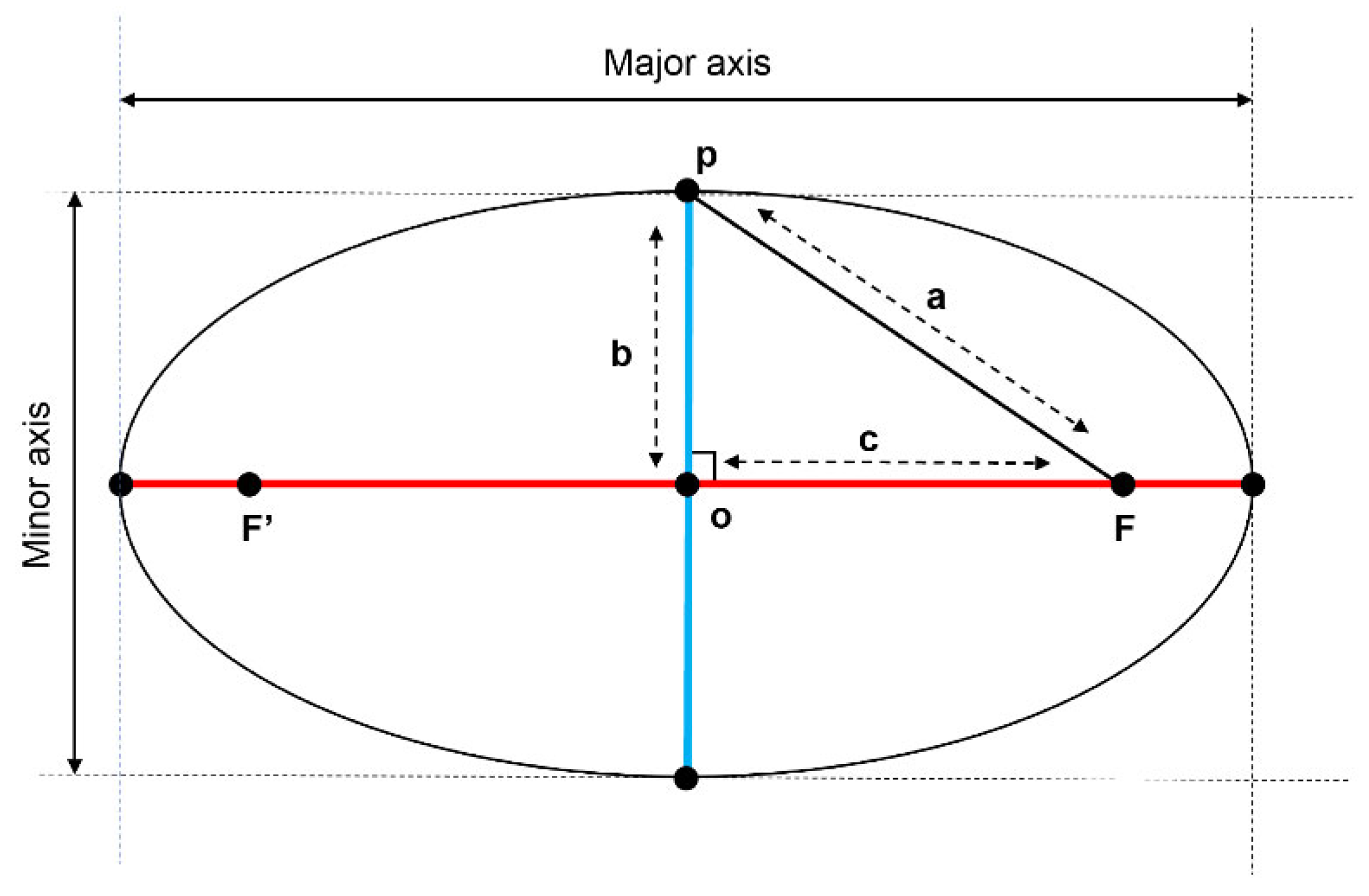


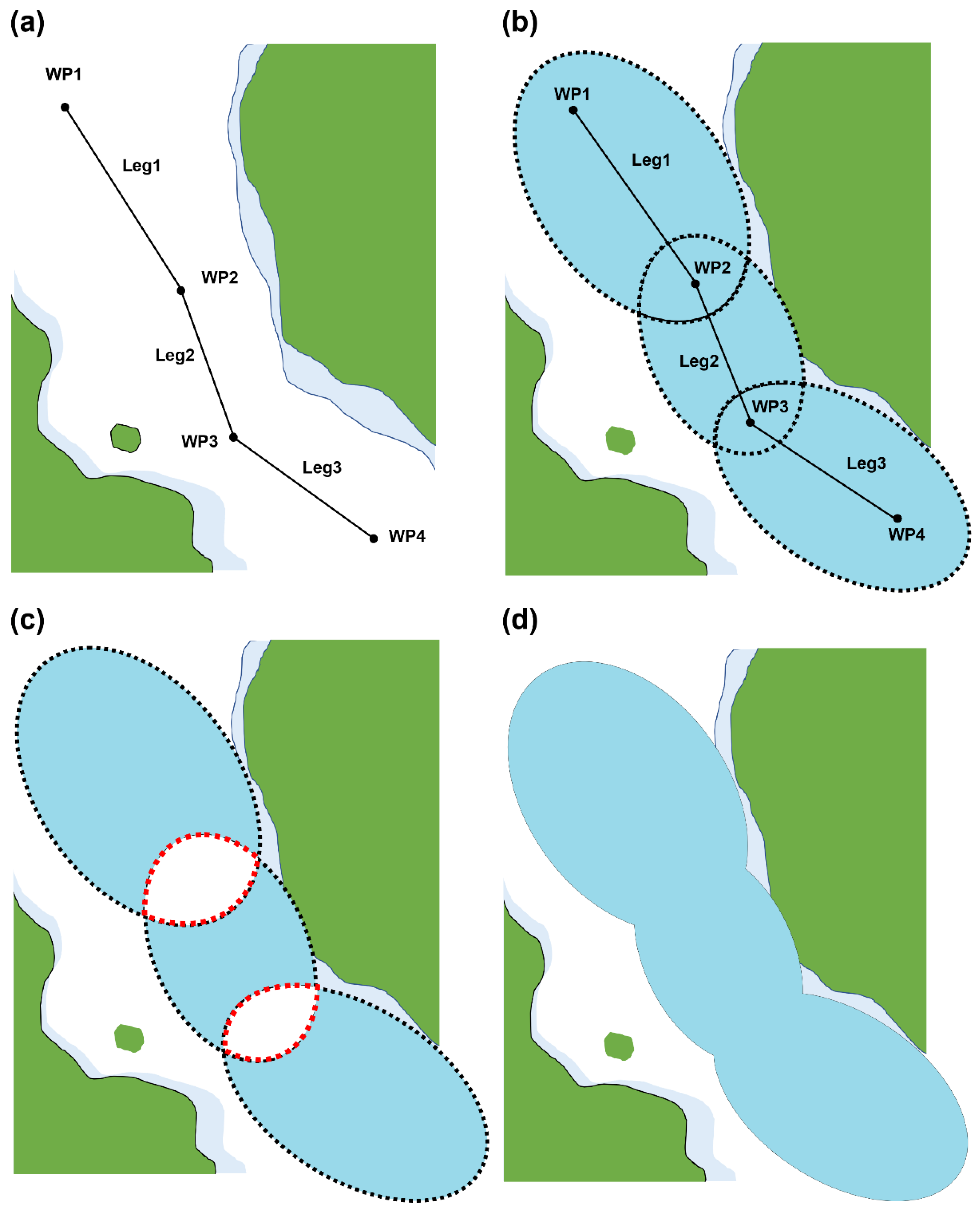

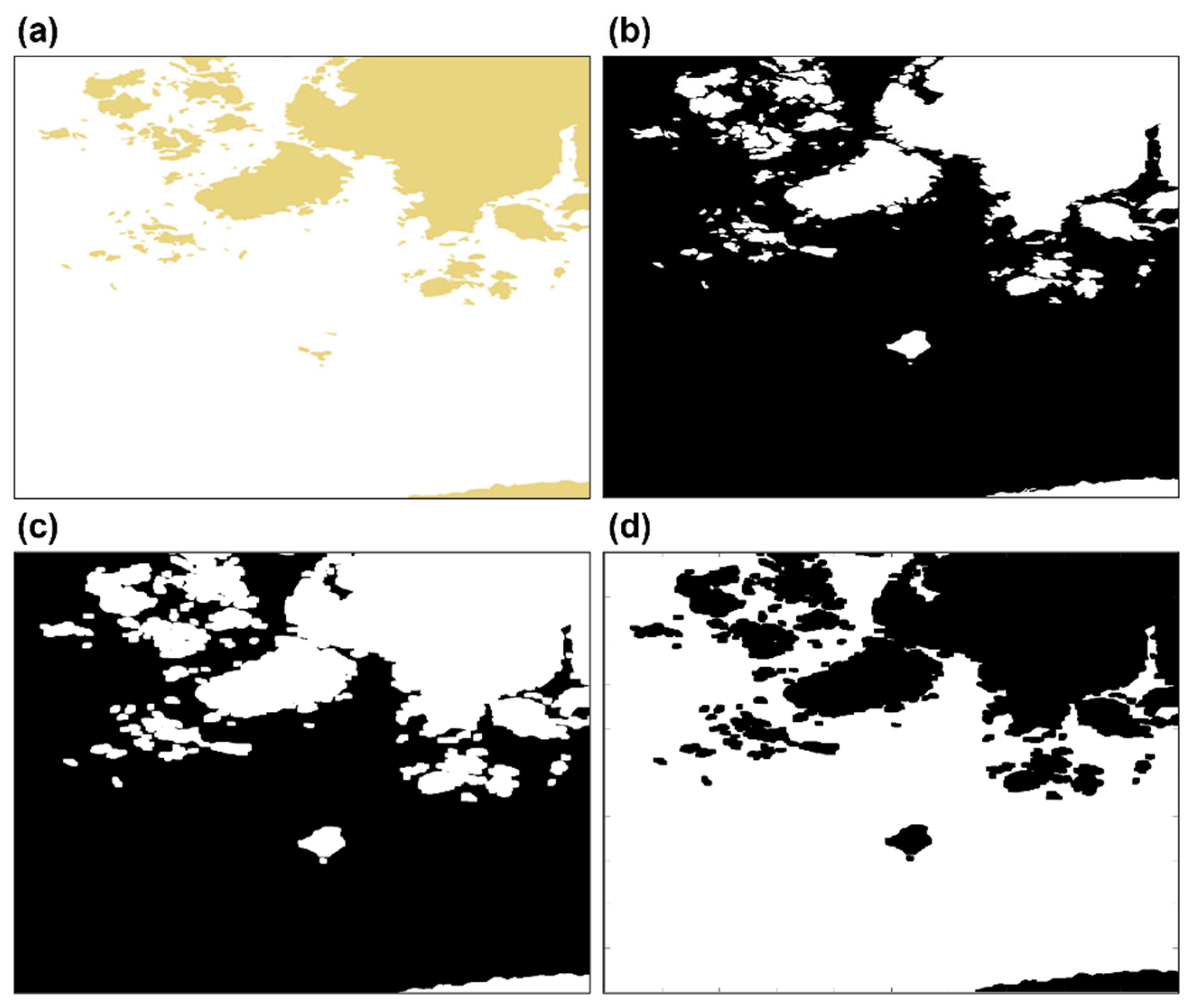
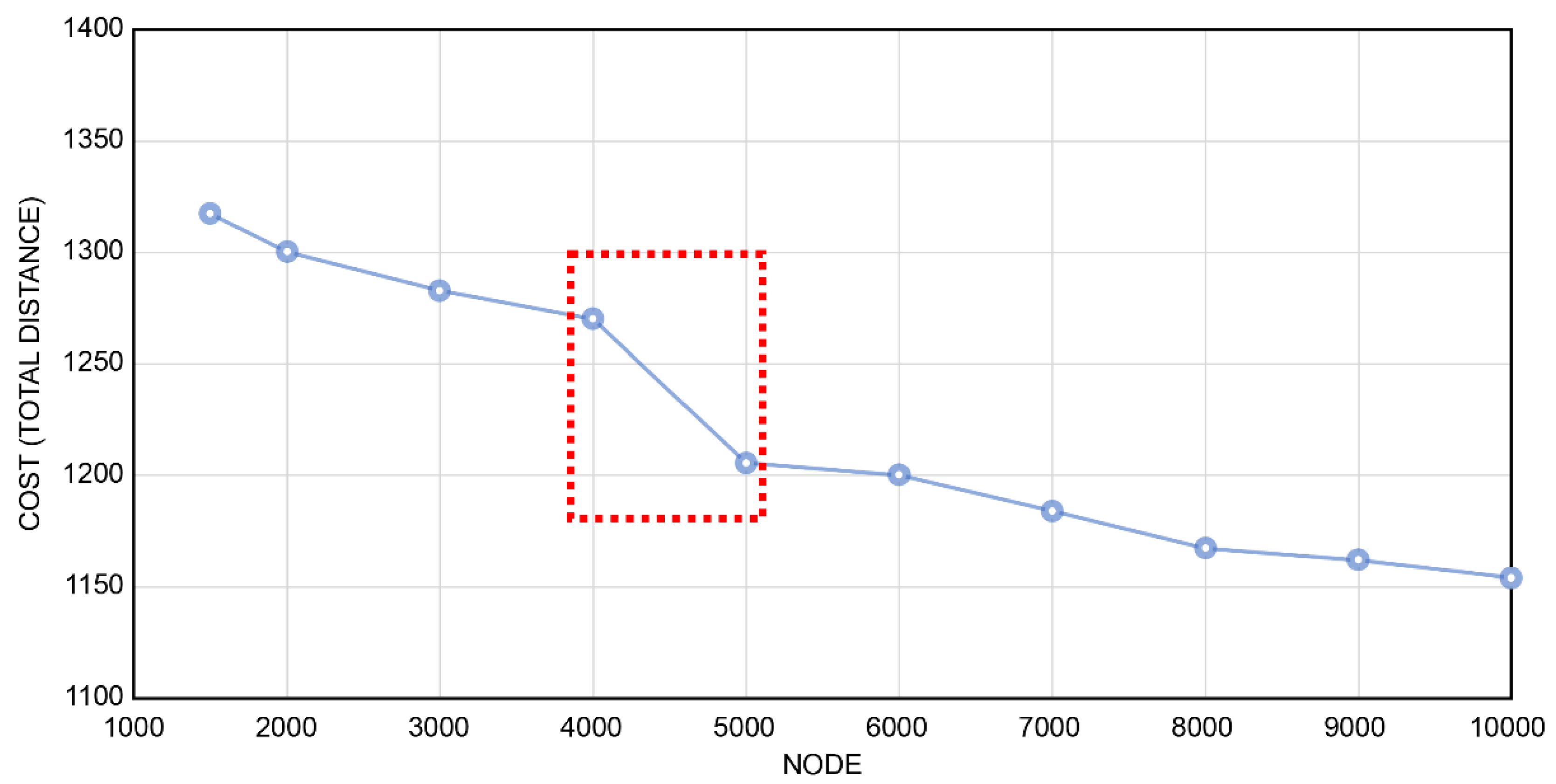

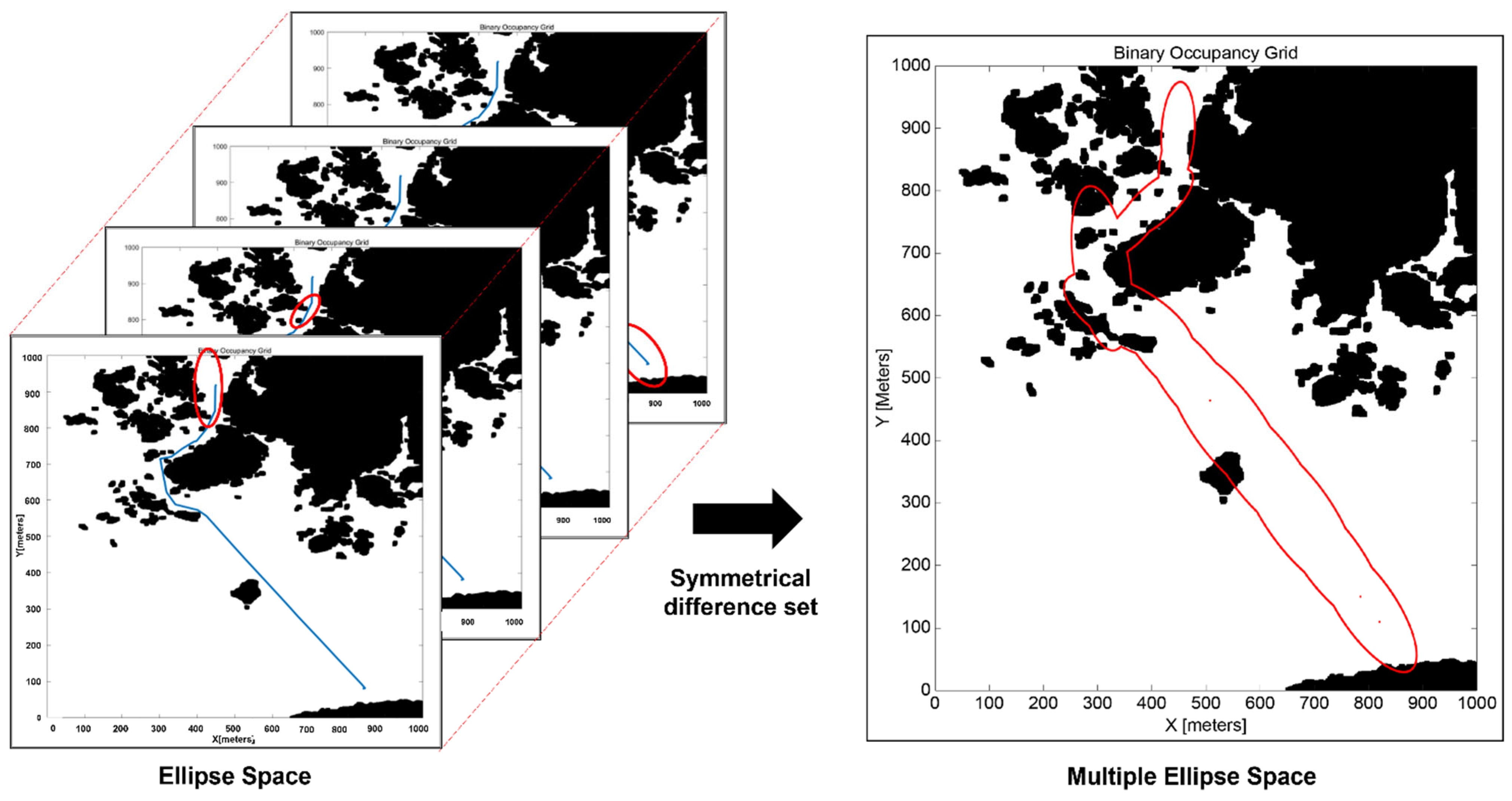
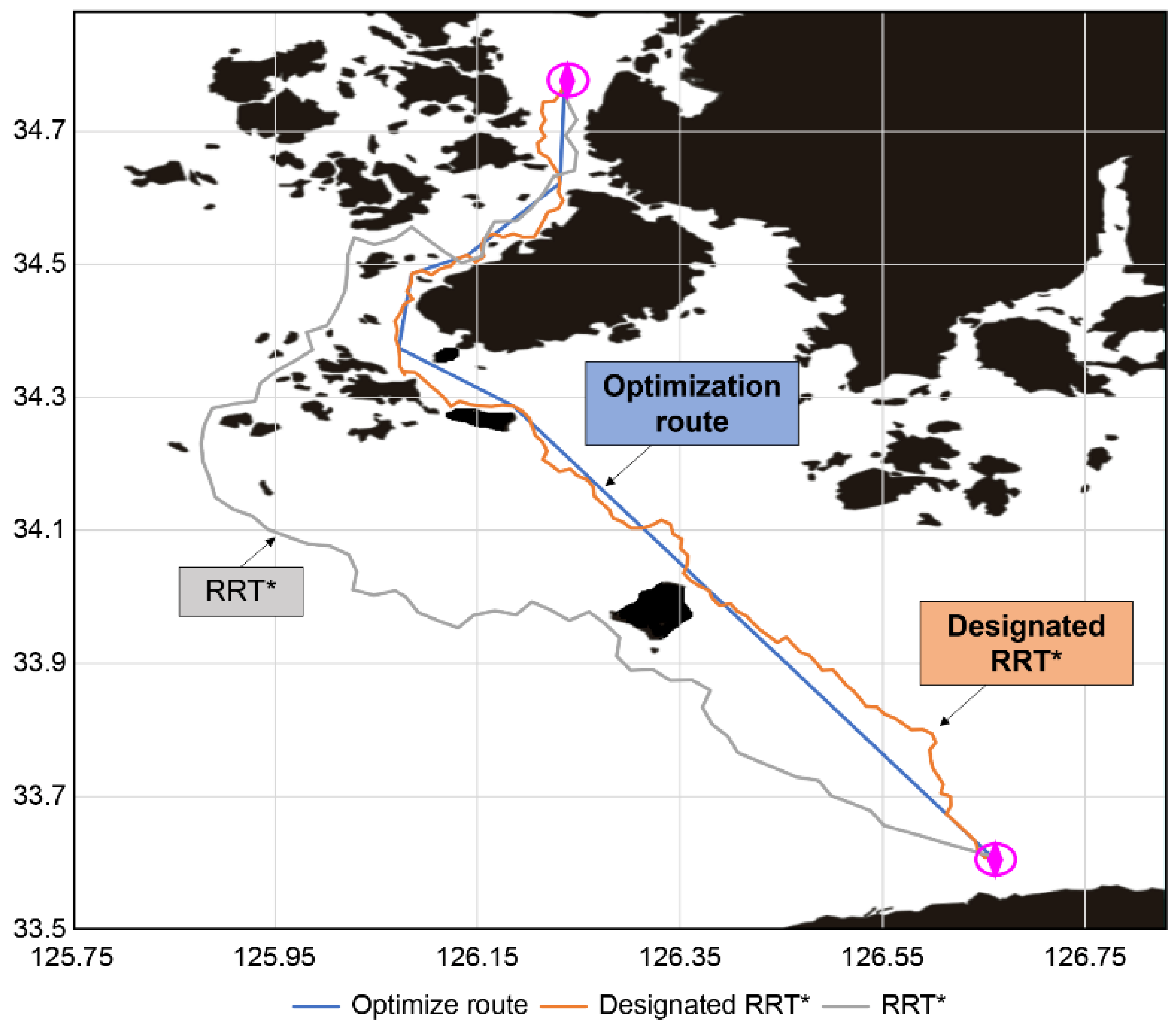
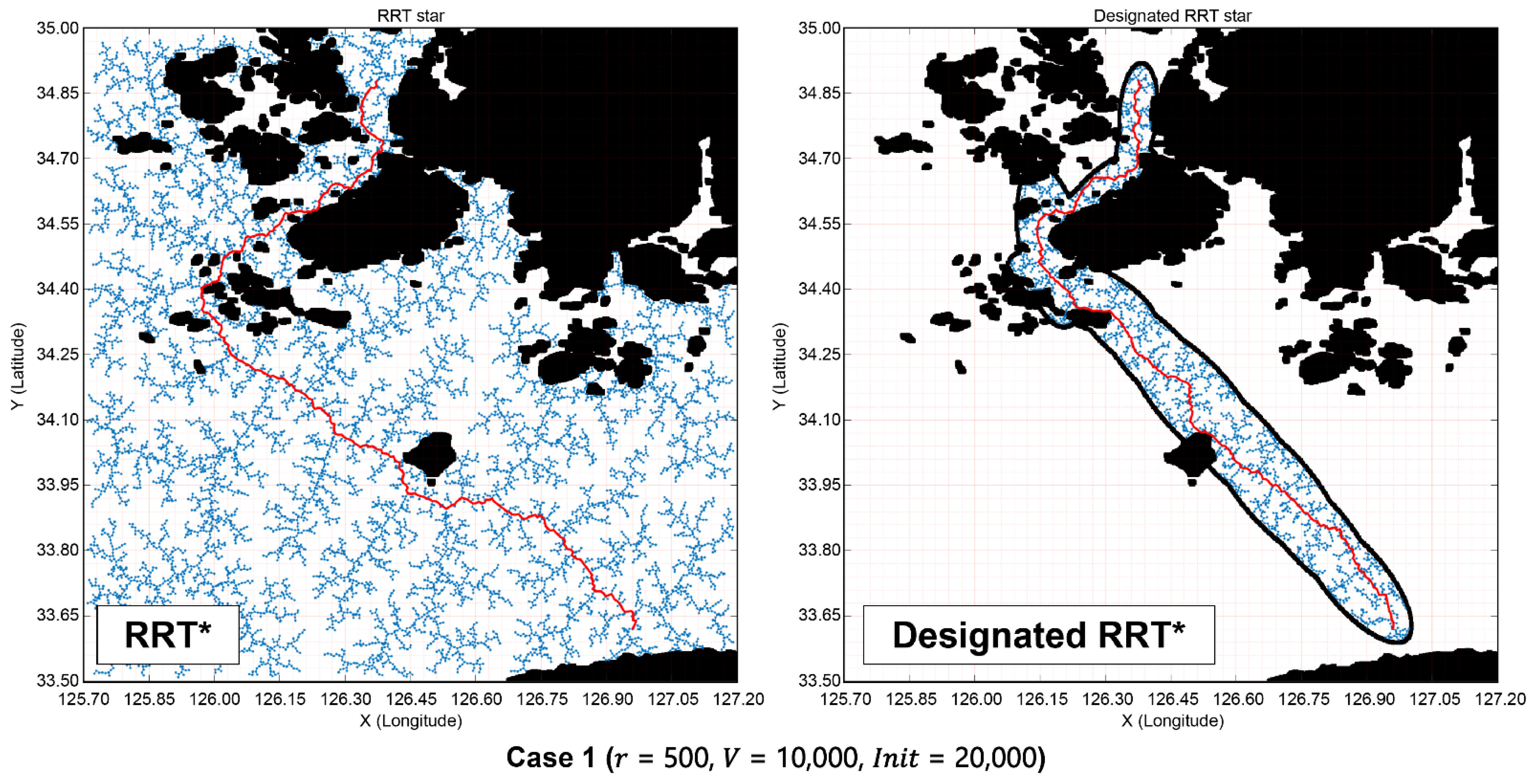
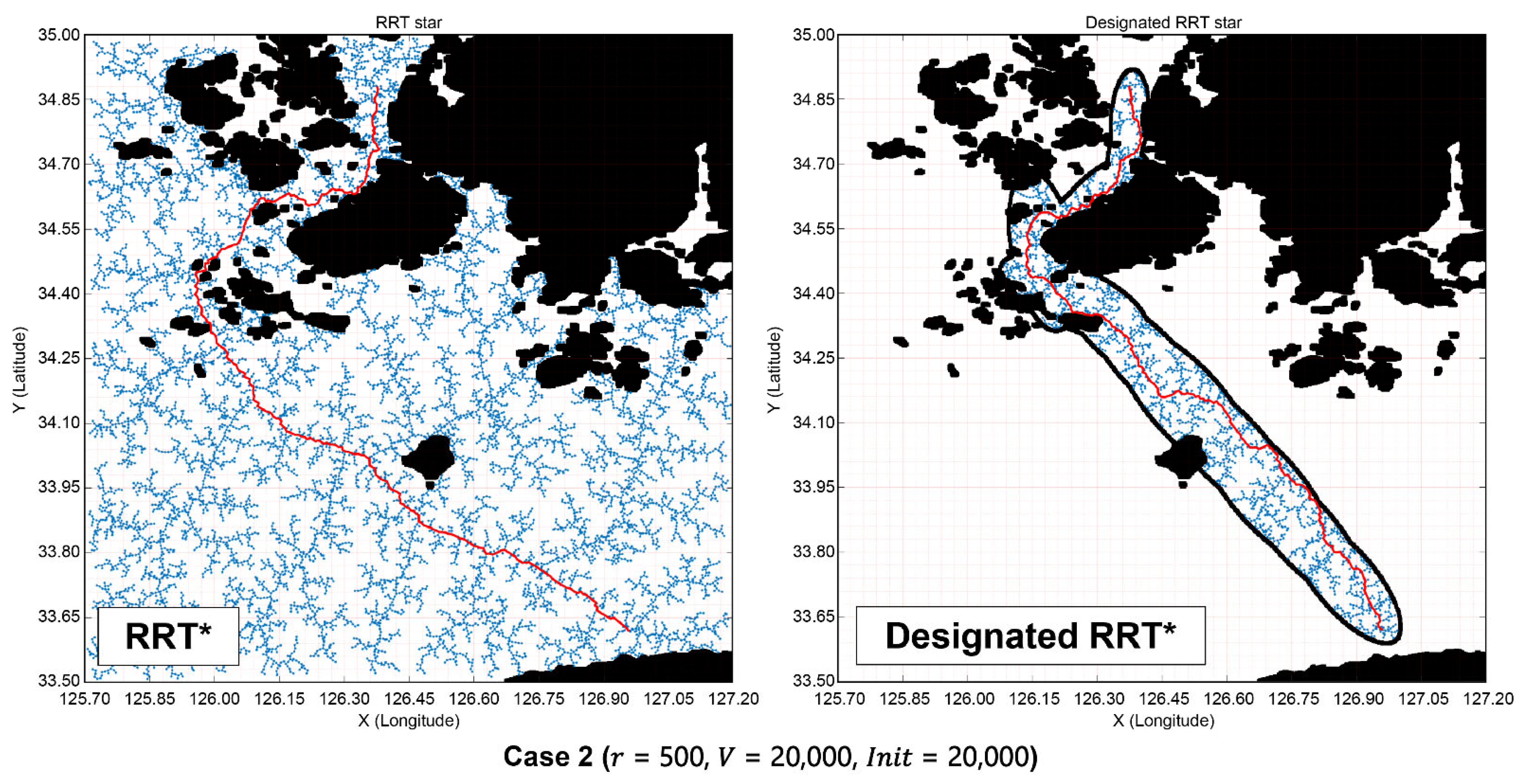
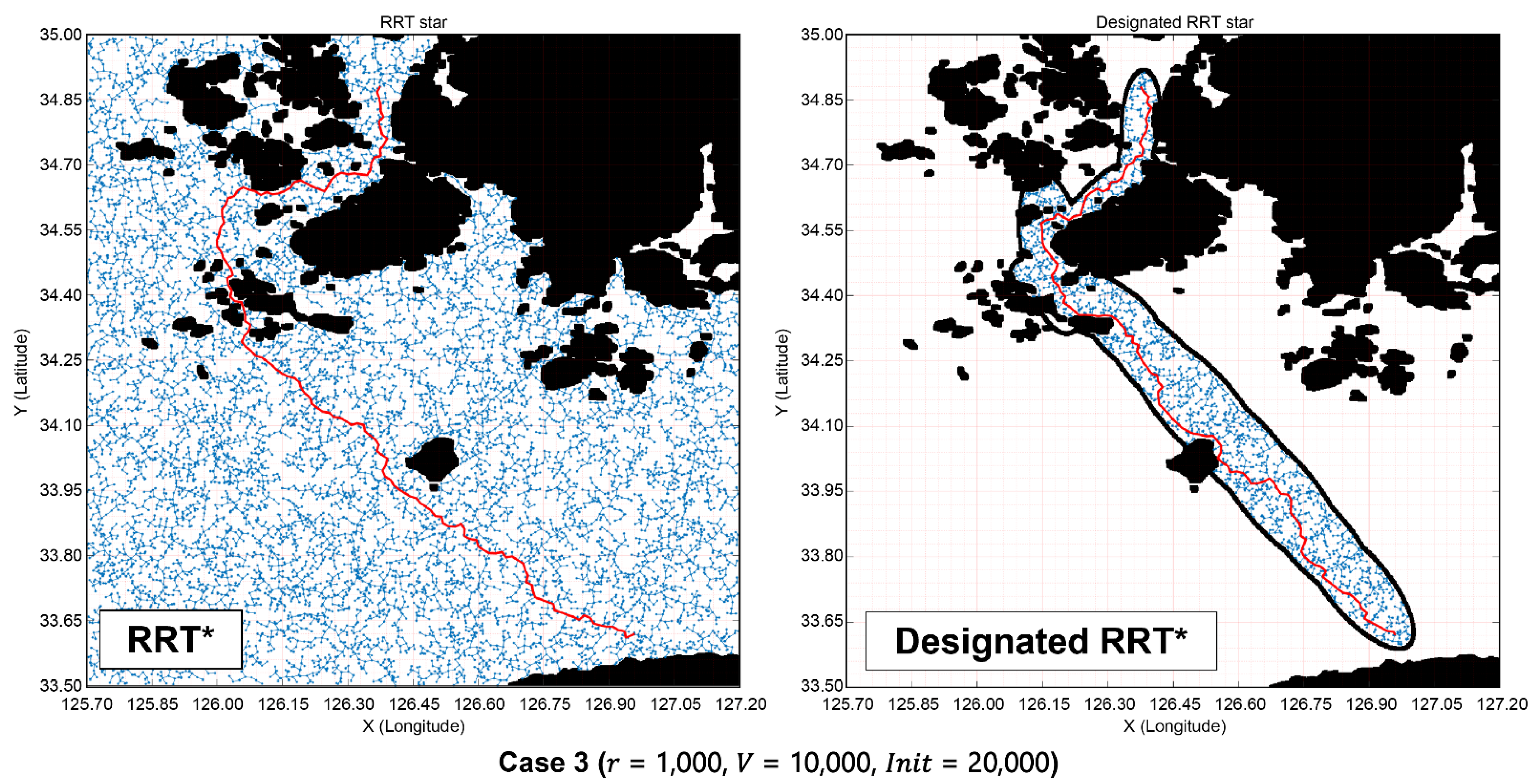

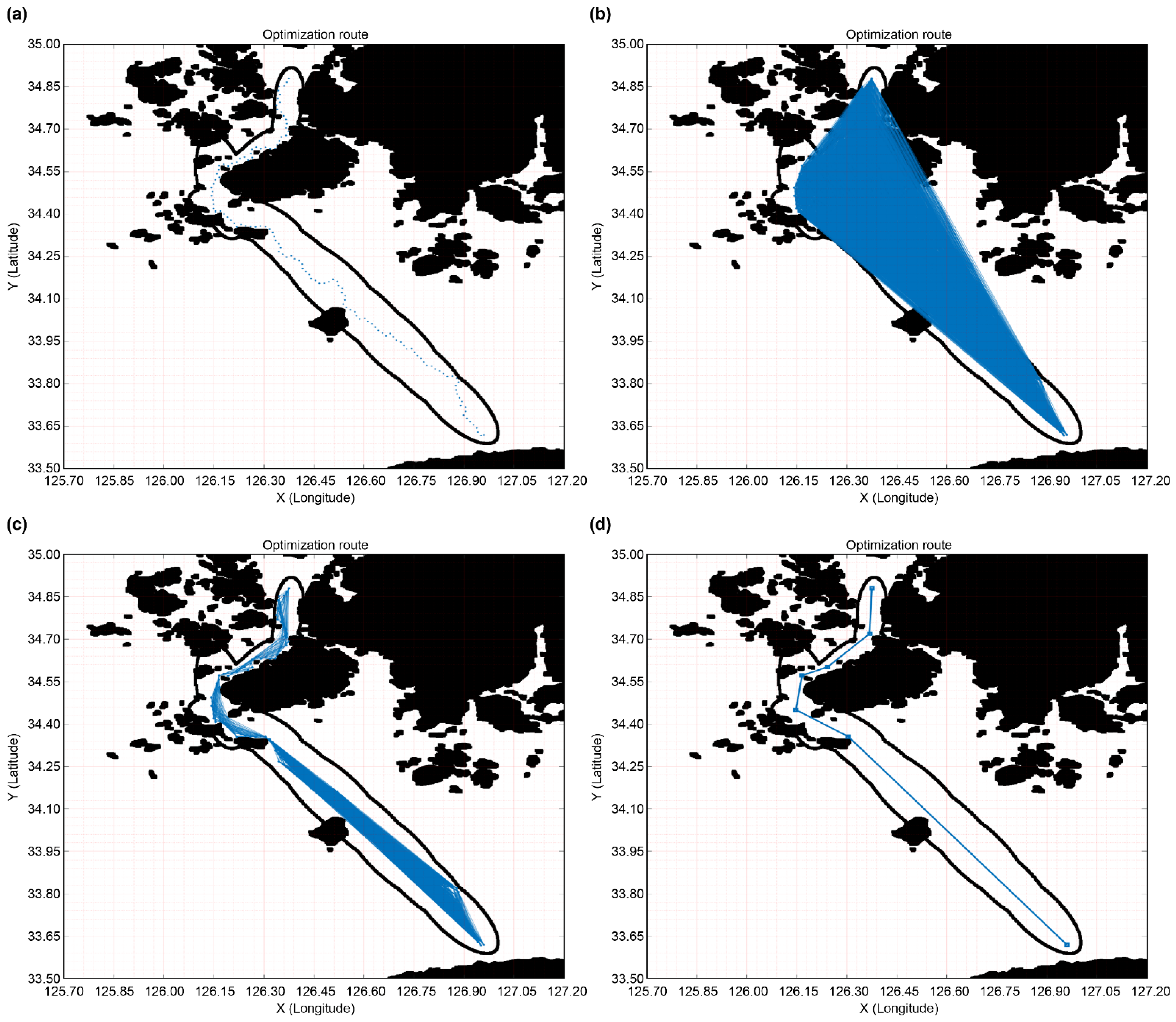
| Application Water | Max. UKC |
|---|---|
| In case of harbor | 10% of maximum draft |
| In case of inner channel or harbor approach without swell | 15% of maximum draft |
| There is a swell, or the route is relatively long | 20% of maximum draft |
| Description | Vessel Speed | Wave Conditions | Channel Bottom | Inner Channel | Outer Channel |
|---|---|---|---|---|---|
| (h) | None | ||||
| >15 kts | 1.15 T | ||||
| All | Low swell | 1.2 T | |||
| Moderate swell | |||||
| Heavy swell | |||||
| Add for Channel Bottom Type | |||||
| All | All | Mud | None | None | |
| Sand/Clay | 0.4 m | 0.5 m | |||
| Rock/Coral | 0.6 m | 1.0 m | |||
| Item | Description | ||
|---|---|---|---|
| Extract range | Lat: 33°30′30″ N~34°50′56″ N, Lon: 125°45′00″ E~126°49′42″ E | ||
| Start point Goal point | 34°27′42″ N, 126°03′45″ E (Mokpo No.1 Pilot Station) 33°34′00″ N, 126°33′00″ E (Jeju Pilot Station) | ||
| Model ship | LOA: 103.4 (m) | Breadth: 15.0 (m) | Max. Draft: 7.0 (m) |
| Simulation Case | 4 Cases |
|---|---|
| Map size | 100 × 100 km |
| 500, 1000 m | |
| 10,000, 20,000 | |
| 5000; 10,000; 20,000; 40,000; 80,000; 160,000; 320,000 | |
| Number of Simulations | 10 |
| Case | Max. | RRT* | Designated RRT* (Proposed) | ||||||
|---|---|---|---|---|---|---|---|---|---|
| Ave. Time | Ave. Cost | * Path | Ave. Time | Ave. Cost | * Path | ||||
| 1 | 500 | 10,000 | 5000 | 1.39 | 171.533 | 6 | 0.65 | 138.965 | 6 |
| 10,000 | 5.03 | 168.655 | 8 | 1.07 | 133.475 | 9 | |||
| 20,000 | 13.74 | 166.709 | 10 | 2.95 | 133.027 | 10 | |||
| 40,000 | 13.62 | 157.779 | 10 | 10.10 | 138.278 | 10 | |||
| 80,000 | 13.50 | 139.386 | 10 | 30.94 | 136.274 | 10 | |||
| 160,000 | 13.64 | 136.204 | 10 | 65.48 | 137.689 | 10 | |||
| 320,000 | 13.47 | 135.802 | 10 | 67.58 | 133.701 | 10 | |||
| 2 | 500 | 20,000 | 5000 | 1.17 | 161.889 | 8 | 0.63 | 135.685 | 7 |
| 10,000 | 3.98 | 161.501 | 8 | 1.54 | 134.081 | 8 | |||
| 20,000 | 19.05 | 161.083 | 10 | 3.80 | 135.567 | 10 | |||
| 40,000 | 51.73 | 150.715 | 10 | 10.07 | 136.405 | 10 | |||
| 80,000 | 51.91 | 149.647 | 10 | 30.27 | 136.939 | 10 | |||
| 160,000 | 52.24 | 146.235 | 10 | 106.15 | 129.276 | 10 | |||
| 320,000 | 51.45 | 145.482 | 10 | 245.52 | 140.125 | 10 | |||
| 3 | 1000 | 10,000 | 5000 | 1.71 | 151.481 | 7 | 0.51 | 137.103 | 7 |
| 10,000 | 5.33 | 150.978 | 9 | 1.25 | 135.718 | 9 | |||
| 20,000 | 13.48 | 150.477 | 10 | 3.22 | 132.783 | 10 | |||
| 40,000 | 13.70 | 157.006 | 10 | 9.21 | 136.412 | 10 | |||
| 80,000 | 13.74 | 153.848 | 10 | 30.05 | 135.819 | 10 | |||
| 160,000 | 13.88 | 149.825 | 10 | 67.59 | 139.589 | 10 | |||
| 320,000 | 14.07 | 147.236 | 10 | 67.30 | 133.694 | 10 | |||
| 4 | 1000 | 20,000 | 5000 | 1.38 | 151.553 | 9 | 0.45 | 138.849 | 8 |
| 10,000 | 4.76 | 151.076 | 10 | 1.25 | 137.700 | 9 | |||
| 20,000 | 22.96 | 150.254 | 10 | 3.30 | 133.824 | 10 | |||
| 40,000 | 53.20 | 148.527 | 10 | 9.29 | 136.088 | 10 | |||
| 80,000 | 52.62 | 147.911 | 10 | 29.78 | 136.526 | 10 | |||
| 160,000 | 52.43 | 145.622 | 10 | 105.46 | 134.624 | 10 | |||
| 320,000 | 53.89 | 144.417 | 10 | 244.77 | 134.239 | 10 | |||
Publisher’s Note: MDPI stays neutral with regard to jurisdictional claims in published maps and institutional affiliations. |
© 2022 by the authors. Licensee MDPI, Basel, Switzerland. This article is an open access article distributed under the terms and conditions of the Creative Commons Attribution (CC BY) license (https://creativecommons.org/licenses/by/4.0/).
Share and Cite
Jang, D.-u.; Kim, J.-s. Development of Ship Route-Planning Algorithm Based on Rapidly-Exploring Random Tree (RRT*) Using Designated Space. J. Mar. Sci. Eng. 2022, 10, 1800. https://doi.org/10.3390/jmse10121800
Jang D-u, Kim J-s. Development of Ship Route-Planning Algorithm Based on Rapidly-Exploring Random Tree (RRT*) Using Designated Space. Journal of Marine Science and Engineering. 2022; 10(12):1800. https://doi.org/10.3390/jmse10121800
Chicago/Turabian StyleJang, Da-un, and Joo-sung Kim. 2022. "Development of Ship Route-Planning Algorithm Based on Rapidly-Exploring Random Tree (RRT*) Using Designated Space" Journal of Marine Science and Engineering 10, no. 12: 1800. https://doi.org/10.3390/jmse10121800
APA StyleJang, D.-u., & Kim, J.-s. (2022). Development of Ship Route-Planning Algorithm Based on Rapidly-Exploring Random Tree (RRT*) Using Designated Space. Journal of Marine Science and Engineering, 10(12), 1800. https://doi.org/10.3390/jmse10121800







